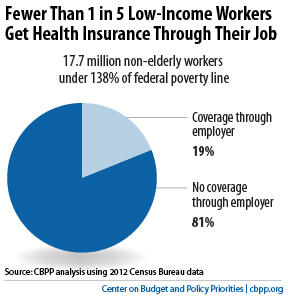Some opponents of health reform’s Medicaid expansion argue that the low-income adults who will qualify for the program are “able-bodied” adults who should be working and getting coverage on their own. But, as our recent fact sheet explains, most of these people are working or live in working families — yet they don’t generally have the same coverage options as the rest of the population:
- 60 percent of adults earning less than 138 percent of the poverty line (the Medicaid limit for any state that adopts the expansion) are working or are in families with full- or part-time workers. In dollar terms, 138 percent of the poverty line this year is roughly $16,000 a year for an individual and $27,000 for a family of three.
- 81 percent of workers earning less than 138 percent of the poverty line don’t get coverage through their employer (see graph). Their employer doesn’t offer coverage or offers coverage that they can’t afford.
- Poor adults generally can’t afford coverage in the individual market. The median annual cost of single coverage in the individual market, including premiums and out-of-pocket costs, was $6,750 in 2007, according to a Commonwealth Fund study — which was 39 percent of the total income of a family of three at the poverty line (which was $17,170 that year).
- Medicaid coverage of poor adults is extremely limited in most states. In the typical state, working parents lose Medicaid eligibility if their incomes exceed 61 percent of the poverty line. The limit for jobless parents is even lower: 37 percent of the poverty line. And poor non-disabled adults without children aren’t eligible for Medicaid at all in most states.
Here’s the bottom line: the lack of coverage options for low-wage workers is precisely the problem that health reform is intended to solve.
